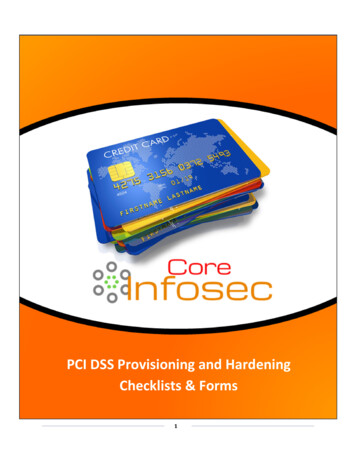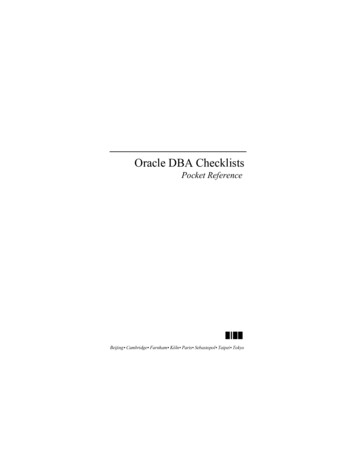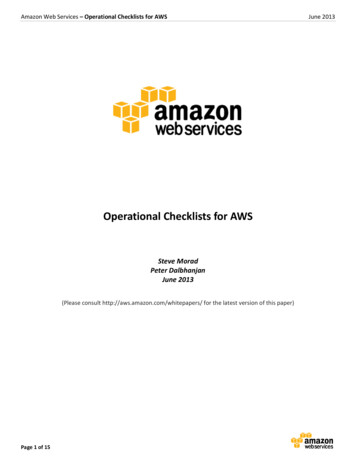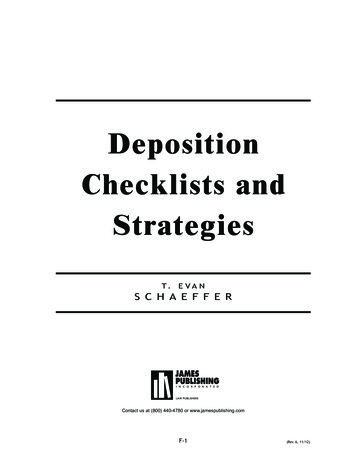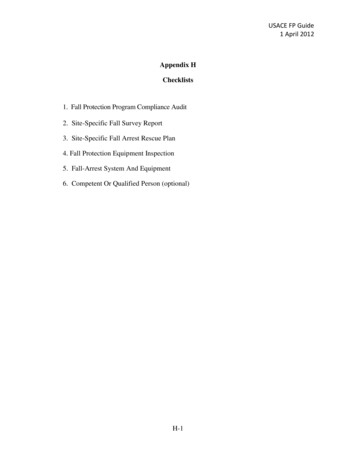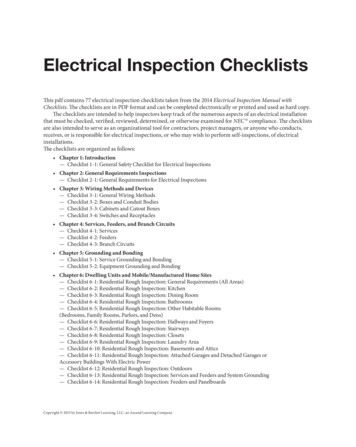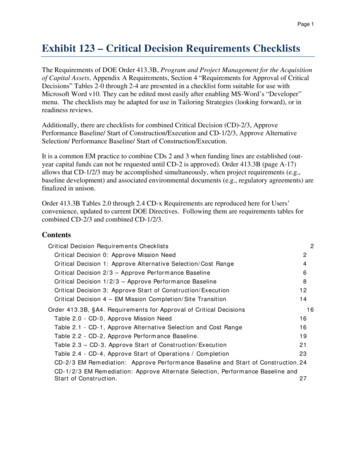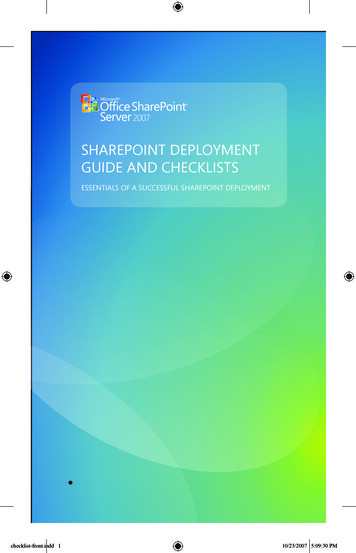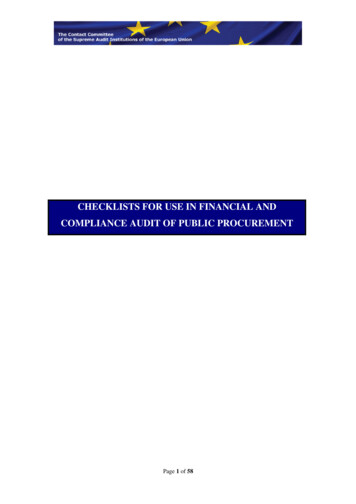
Transcription
CHECKLISTS FOR USE IN FINANCIAL ANDCOMPLIANCE AUDIT OF PUBLIC PROCUREMENTPage 1 of 58
INTRODUCTIONThe scope of public procurement is broad and incorporates a wide range of activitiesincluding, acquiring goods and services at an appropriate quality and quantity,bundling supply needs with other departments, outsourcing services and establishingpartnerships with suppliers. In all cases the public body has to choose a supplier andpay for the goods delivered or service provided. In most of the EU Member States,procurement represents between 25% to 30% of public spending.Supreme Audit Institutions (SAIs) audit the use of public resources and, depending onmandates, may also promote sound management principles and the attainment ofvalue. The audit mandates and activities of SAIs vary, as do national budgetingsystems and public procurement regulations. Drafting a common checklist to be usedwhen auditing public procurement processes was a difficult task, not least because wehad to produce a document which was relevant and applicable to auditors operatingwithin different frameworks, objectives, requirements and procedures.An auditor may examine the procurement function as part of an audit of the accountsof a specific public authority. Alternatively he/she may be interested in examiningspecific areas or procedures and in considering efficiency, competition, fraud andcorruption, regularity, fitness for purpose or value added. Some SAIs may strive torecommend good practice while others may concentrate on matters of compliance andthe action taken in response to identified irregularities.The checklist was prepared on the basis of common principles and procedures havingregard to: An analysis of the contributions received from several of the SAIs which led us toconclude that all of them focus on the robustness of the procurement function,meeting public needs, competition objectives and transparent procedures; EU Member States are bound to the basic precepts of the Treaty on theFunctioning of the European Union (TFUE) and of the Directive 2004/18/EC1; No matter which national or local regulation is followed, State authorities mustrespect the requirements of the competitive process and make its decisions in atransparent way which respects all participants equally. In particular it must notdiscriminate on the grounds of nationality; Procurement is a risk area for fraud and corruption and they usually result in themisuse of public resources.While the checklists closely follow the requirements of the EU Directive, they aregeneral in nature and is applicable to purchases falling below the EU threshold limits.They also address some relevant questions not included in the EU Directive, e.g.organisational issues. In addition, we have placed emphasis on aspects which weknow from experience are prone to failure and irregular influence.1Although there are other EU regulations on public procurement, this checklist refers always toDirective 2004/18/EC. ruling.Page 2 of 58
When using this checklist, the auditor should keep in mind that: The evaluation of public procurement processes may be only a part of the audit (asin the case of a financial audit), and, thus, the proposed questions may have to beintegrated within the broad methodology of that audit; Depending on assessed risks, not all questions will be applicable to each audit; According to audit mandates and national systems, some items may have to bemodified or questions added. For instance, financing through national, state orlocal budgets will put the procuring entity under the obligation of following therelevant national, state or local financial and procurement regulations; Where an audit is planned to include value for money questions, items from thesechecklists should be considered along with those included in the ProcurementPerformance Model.The checklists begin with an analysis of the procurement function, and thereafter isorganised according to the main stages of the procurement process such as pre-tenderstage, choice of procurement procedure, publicity and notifications used,identification of potential bidders, evaluation of tenders and award procedure. Aspecific attention is given to additional works and supplies as a frequent form of directcontracting.Each chapter has a number of main questions, which are then presented in thefollowing format: Background, explaining the importance and giving some relevant information; Questions, detailing the areas and directions in which that item should beinvestigated; Guidance, identifying documents that the auditor should consider in relation tothe item under analysis:- The relevant parts of the Directive 2004/18/EC;- The related sections of the Guideline for Auditors;- Questions included in the Procurement Performance Model;- Important judgements of the European Court of Justice (ECJ Case-Law);- Audit reports and studies produced by SAIs2.Since public procurement is one of the activities creating more opportunities forcorruption, which originate damages estimated between 10% to 50% of the contractvalue, we have included a fraud and corruption perspective in these checklists. Wherethe audit emphasis is on fraud and corrupt practices, then the auditor should takeF/Cspecial note of those questions highlighted with the following red flag:. If theanswer to those questions is “No” increased risks of fraud and corruption are probableand further analysis is needed3.2Summaries, details and links to these reports are included in “Supreme Audit Institutions Summariesof Procurement3See AFROSAI-E guideline “Detecting fraud while auditing” for a global approach, for fraud checklistand for audit procedures, risks and suggested controls for selected audit areas, including procurement(on request to AFROSAIE).For types of fraud and corruption in contracts and warning signs of possible fraud and corruption incontracts see “ASOSAI Guidelines for Dealing with Fraud and Corruption” m. See also Fighting Corruption and PromotingIntegrity in Public Procurement, OECD, 2005.Page 3 of 58
1. AUDITING THE MANAGEMENT OF THE PROCUREMENT FUNCTION1.1.1.2.1.3.1.4.Are procurement processes well organised and documented?Are proper financing arrangements taken?Are internal control systems in place?Is procurement execution duly monitored and documented?2. AUDITING THE PREPARATION OF THE PROCUREMENT2.1.2.2.2.3.2.4.Are EU procurement regulations applicable?Did the public authority calculate the contract value accurately?Was the performance description adequate to needs and legal requirements?Were the tender documents comprehensive, transparent and free fromrestrictions or conditions which would discriminate against certain suppliers?2.5.Was the submission of variant tenders accepted and duly ruled?2.6.Has the public authority procedures in place to monitor the input of expertsemployed to assist the procurement function?3. AUDITING THE PROCEDURE CHOSEN TO PROCURE3.1.Did the public authority decide upon an adequate and admissible procurementprocedure?3.2.Did the chosen procedure ensure fair competition and transparency?4. AUDITING THE PUBLICITY AND NOTIFICATIONS USED4.1.Did the public authority report procurement processes and results incompliance with the Directives and the TFUE?4.2.Was timely and equal access to contract documents and information providedto all candidates?4.3.Was confidentiality ensured when necessary?5. AUDITING THE AWARD PROCEDURES5.1.5.2.5.3.5.4.5.5.Was the formal review of requests to participate or evaluation of bidscorrectly undertaken?Was suitability of candidates accurately assessed?Were exclusion causes duly considered before the actual evaluation oftenders?Were bids properly evaluated?Was the decision on the award process accurate and adequatelycommunicated?Page 4 of 58
6. AUDITING ADDITIONAL WORKS OR DELIVERIES6.1.Were any additional works or deliveries admissible, without recourse to anew procurement procedure?Page 5 of 58
1. AUDITING THE MANAGEMENT OF THEPROCUREMENT FUNCTION1.1. Are procurement processes well organised and documented?BackgroundThe organisation and assignment of responsibilities within the procurement process iscritical to the effective and efficient functioning of that process.The public authority must document all measures and decisions taken in aprocurement process, in order to be able to follow progress, to review it whennecessary and to support management decisions.This organisation and documentation measures also form the basis for financial andcompliance controls applied in the procurement process.QuestionsF/C F/C F/C F/C F/C Are the functions and responsibilities of those involved in theprocurement function clearly established and documented?Have guidelines incorporating the principles and objectives of a robustprocurement practice been established?Are procurement processes organised and documented and include:needs to be addressed, contract performance description, documentation,notifications, award procedure and decision, draft and concludedcontract, physical execution and payments made?Are procedures conducted by electronic means sufficiently recorded anddocumented, making the audit trail easy to follow?Do staff involved in the various stages of the process have theappropriate skills and training to perform their duties effectively?Are procurement proposals initiated, processed and approved byauthorized officers, with no cases of overstepping?Are there no cases of documents missing, altered, back-dated or modifiedor after-the-fact justifications?Guidance Directive4:For records of e-procedures see article 43 PPWG Procurement Performance Model (PPM):For procurement strategy see nº 7 of PPM.For organization of the procurement function see nº 8 of PPM.For organization of the procurement process see nº 9 of PPM.For staff’s skills, experiences and competencies see nos 10 and 16 of PPM.For risks relating to internal and external environments see nº 13 of PPM.4It always refers to Directive 2004/18/ECPage 6 of 58
For capturing and using performance data see nº 14 of PPM. Audit reports and studies:For clear identification of functions:ReportManagement of public procurement at theministry of Interior and its governing areaManagement of procurement at the Ministry ofEnvironmentSAIEstoniaEstoniaFor the need of guidelines:ReportContract marketing and promotion expenditureSAIBelgiumFlemish Broadcasting Corporation (VRTT)’scooperation with external services for televisionprogrammesProcurement of maintenance servicesStatistics Finland’s service procurementsThe Defence administration’s procurementactivities – supply procurementAudit on the operation of the HungarianDefence Forces public procurement systemsprojects“EstoniaFinland“HungaryFor the organization, documentation and filing of procurement processes:ReportFlemish Broadcasting Corporation (VRT)’scooperation with external services for televisionprogrammesConsultancy contracts awarded by ministerialcabinetsManagement of public procurement at theMinistry of Interior and its governing areaStatistics Finland’s service procurementsUniversities’ procurement activitiesProcurements of system work and ADPconsulting services by the tax administrationAnnual report on federal financingmanagement, Part IIContracts of assistance, consultancy andservices awarded by the Foundation for FurtherEducation, financial years 1996 to or qualification of procurement staff:ReportImproving public services through betterconstructionImproving IT procurement: the impact of theOffice of Government Commerce’s iniciativeson departments and suppliers in the delivery ofMajor IT-enabled projectsPage 7 of 58SAIUKUK
For competency issues:ReportContract marketing and promotion expenditureRoads, motorways and waterways maintenanceleasesPage 8 of 58SAIBelgiumBelgium
1. AUDITING THE MANAGEMENT OF THEPROCUREMENT FUNCTION1.2. Are proper financing arrangements taken?BackgroundThe financing of procurement contracts is particular to the budgetary frameworkapplicable to the public body and in operation in the Member State. In examiningprocurement during the financial audit process, many audit approaches examine thefinancing arrangements as part of their testing of compliance with national legislation,financial rules and authorities.QuestionsF/C F/C Has the procurement under review and the related funding beenapproved at the appropriate level (e.g. government, ministry, board,head of body)?Is this funding legal or otherwise in compliance with relevant nationallaws or procedures governing the financing of this type of contract?Have the funding arrangements been agreed where payments take placeover several financial periods?Does the approved level of funding correspond to the estimated value ofthe contract calculated for the purpose of the procurement process?Is funding made available for payments under the contract at theappropriate time and in accordance with the relevant national/publicfinancial procedures?Where funding is being arranged by borrowings, do these have thenecessary approval and legal authority?Guidance Check national financial regulations PPWG Procurement Performance Model (PPM):For risk of external environment/budgetary constraints see nº 13 of PPM Audit reports and studies:For budgetary funding issues:ReportContract marketing and promoting expenditureManagement of public procurement at theMinistry of Interior and its governing areaManagement of procurement at the Ministry ofEnvironmentThe Finnish state’s payment traffic procurementPage 9 of 58SAIBelgiumEstonia“Finland
Acquisitions of medications and pharmaceuticalproducts in a sample of public hospitals of theNational Health System-1999 and 2000Page 10 of 58Spain
1. AUDITING THE MANAGEMENT OF THEPROCUREMENT FUNCTION1.3. Are internal control systems in place?BackgroundThe procurement process interacts with the other financial controls that have beenestablished in order to safeguards assets and prevent fraud or financial error. In somefinancial audit approaches the procurement process is examined as an integral part ofthe system of internal control.QuestionsF/C F/C F/C F/C F/C Is there a system in place which controls requisitions, records contractperformance and payments made and which sets out:o Those responsible for the various procedures includingassessment of needs and authorisation levelso Data to be recordedo Specific procedures to be adopted in ordering goods and servicesunder agreed contract(s)o Procedures for verifying that goods/services have been properlydelivered/performed and are in accordance with the contracttermso Procedures for approving payments, including reconciling claimsmade under the contract to delivery/performance records andchecking the arithmetical accuracy of the payment requestso Management monitoring of transactions and balances?o Enforcement of compliance in case contractors fail to meetcontract termso Regular accounting reconciliations of contract payments,transactions and inventory?Is there appropriate segregation of duties between those procuringservices, requisitioning goods / services, verifying the performance of thecontract and approving payments?Have mechanisms to avoid conflicts of interests in the procurementprocesses been established?Are there no indications or evidences of conflicts of interest by officersauthorizing transactions or by members of committees involved in theprocurement processes?Are there no indications or evidences of repeated, unusual orunnecessary contacts by officers authorizing transactions or by membersof committees involved in the procurement processes with contractors?Page 11 of 58
F/C F/CF/C F/CF/C F/C Does an appropriate official review the procurement process on anongoing basis to ensure that it is in compliance with applicable rules?Do controls exist for e-procedures and records, covering in particular:o Access to data, including standing data, and the identification ofrestriction levels and authorised personnel?o Proper and complete records of transactions and events aremaintained?o Transactions are properly verified after input or modification?o Is data securely stored?Are there no materials provided to contractors who, according to thecontracts, are supposed to provide them (such as office space, furniture,IT equipment) and no cases of employees from the contracting authorityperforming parts of contracted work?Are cases of double payment duly prevented and corrected?Guidance Directive:For records of e-procedures see article 43 PPWG Procurement Performance Model (PPM):For the organization of the procurement function see nº 8 of PPM.For public procurement function controls see nº 11 of PPM.For risk management see nº 13 of PPM.For malpractice and fraud in the procurement function see nº 14 of PPM.For conflicts of interests and corruption see nº 17 of PPM. Audit reports and studies:For the need of an effective internal control system:ReportContract marketing and promotion ted with the purchase of specific militaryequipmentFlemish Broadcasting Corporation (VRT)’scooperation with external services for televisionprogrammesManagement of public procurement at theMinistry of Interior and its governing areaFile, storage, safekeeping or management ofmedical histories and past procurement or inforce in 1999 and 2000 on this activity for asample of public hospitals of the NationalHealth SystemModernising procurement in the prison serviceImproving IT procurement: the impact of theOffice of Government Commerces’ initiaves ondepartments and suppliers in the delivery ofmajor IT-enabled projectsFor the need of clear segregation of duties:ReportPage 12 of 58SAIBelgium““EstoniaSpainUK“SAI
Contract marketing and promotion expenditurePublic investment projects by the NationalLaboratory for Civil EngineeringFor preventing conflicts of )’s cooperation with externalservices for television programmesProcurement of consultancy servicesPage 13 of 58BelgiumPortugalSAIBelgiumDenmark
1. AUDITING THE MANAGEMENT OF THEPROCUREMENT FUNCTION1.4. Is procurement execution duly monitored and documented?BackgroundMonitoring of contracts and the procurement process allows management to assessover time the effectiveness of procurement controls, contract performance andcompliance with financial and other legal authorities, reducing scope for misuse ofpublic resources. It involves assessing procurement execution and related controls ona timely basis and taking necessary corrective actions.QuestionsF/C F/C F/C F/C F/C F/C Are the responsibilities for monitoring the execution and performance ofcontracts clearly assigned?Are those responsibilities discharged by personso With the appropriate authority to take actions in the event ofnon-compliance?o With the appropriate skills, technical knowledge and/or abilityto effectively ensure the proper execution and performance ofthe contract?Are reports based on sound data available to those responsible formonitoring the performance of contracts?Are order quantities, deliveries and payment levels under the contractmonitored by an appropriate official?Does an appropriately qualified official check the quality of performanceagainst the contract terms?Are there systems for recording and managing stocks (where part ofcontract)?Are there established procedures for dealing with and documenting nonperformance and return of goods?Is there an adequate and appropriate record for monitoringperformance and any resulting or follow up actions?Guidance PPWG Procurement Performance Model (PPM):For regular evaluation of the procurement function see n. 8 of PPM.For public procurement function controls see nº 11 of PPM.For evaluation of suppliers’ performance see nº 12 of PPM.For malpractice and fraud in the procurement function see nº 14 of PPM.Page
An auditor may examine the procurement function as part of an audit of the accounts of a specific public authority. Alternatively he/she may be interested in examining specific areas or procedures and in considering efficiency, competition, fraud and corruption, regularity, fi

